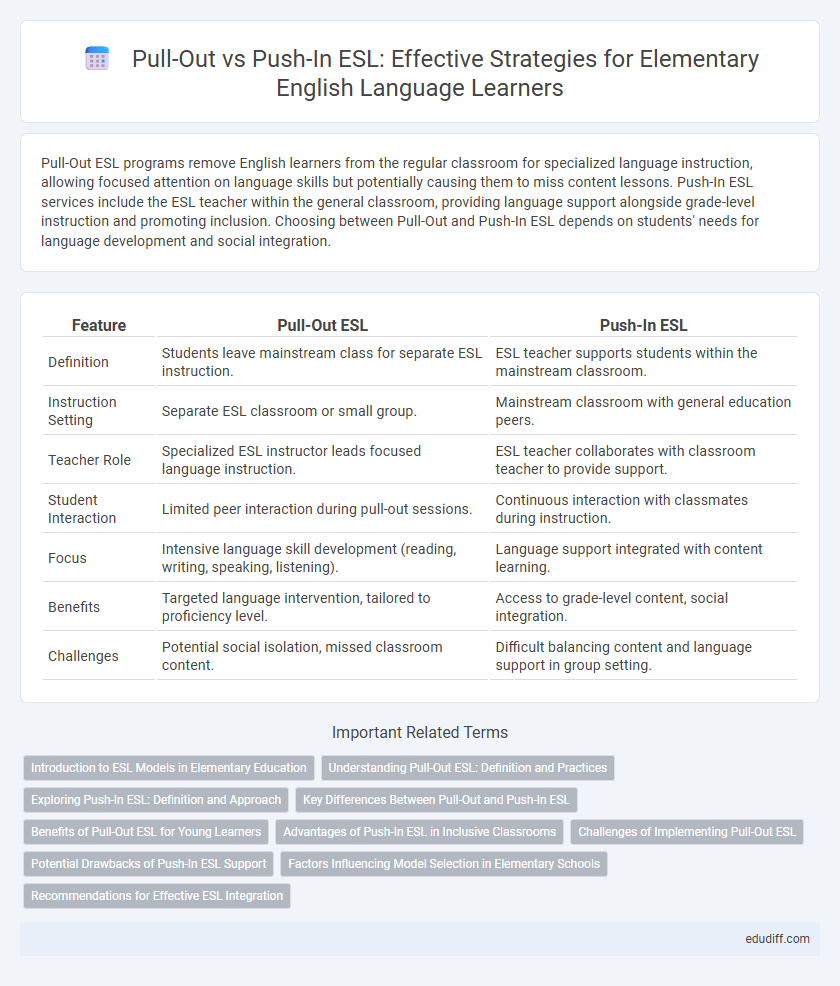Pull-Out ESL programs remove English learners from the regular classroom for specialized language instruction, allowing focused attention on language skills but potentially causing them to miss content lessons. Push-In ESL services include the ESL teacher within the general classroom, providing language support alongside grade-level instruction and promoting inclusion. Choosing between Pull-Out and Push-In ESL depends on students' needs for language development and social integration.
Table of Comparison
| Feature | Pull-Out ESL | Push-In ESL |
|---|---|---|
| Definition | Students leave mainstream class for separate ESL instruction. | ESL teacher supports students within the mainstream classroom. |
| Instruction Setting | Separate ESL classroom or small group. | Mainstream classroom with general education peers. |
| Teacher Role | Specialized ESL instructor leads focused language instruction. | ESL teacher collaborates with classroom teacher to provide support. |
| Student Interaction | Limited peer interaction during pull-out sessions. | Continuous interaction with classmates during instruction. |
| Focus | Intensive language skill development (reading, writing, speaking, listening). | Language support integrated with content learning. |
| Benefits | Targeted language intervention, tailored to proficiency level. | Access to grade-level content, social integration. |
| Challenges | Potential social isolation, missed classroom content. | Difficult balancing content and language support in group setting. |
Introduction to ESL Models in Elementary Education
Pull-Out ESL models involve removing students from mainstream classrooms for specialized English instruction, enhancing language acquisition through focused teaching. Push-In ESL integrates language support within the regular classroom, allowing students to develop English skills alongside grade-level content. Both models aim to improve English proficiency but differ in instructional setting and student interaction.
Understanding Pull-Out ESL: Definition and Practices
Pull-Out ESL is a specialized instructional approach where English Language Learners (ELLs) are temporarily removed from their mainstream classrooms for targeted language support. This method allows for focused, small-group or one-on-one teaching tailored to the students' proficiency levels in speaking, listening, reading, and writing English. Effective Pull-Out ESL practices emphasize individualized learning plans and progress monitoring to accelerate language acquisition and academic achievement.
Exploring Push-In ESL: Definition and Approach
Push-In ESL involves integrating English language learners directly into mainstream classrooms, where ESL specialists collaborate with general education teachers to support language acquisition. This approach emphasizes real-time language development through content immersion, promoting inclusivity and minimizing interruptions to students' social and academic routines. Teachers use tailored strategies such as scaffolding and differentiated instruction to address diverse language proficiency levels within the general education setting.
Key Differences Between Pull-Out and Push-In ESL
Pull-Out ESL programs remove students from mainstream classrooms for specialized language instruction, allowing focused skill development in small groups. Push-In ESL services integrate language support within the regular classroom, promoting real-time learning alongside peers and facilitating content comprehension. Key differences include the instructional setting, degree of inclusion, and opportunity for immediate application of language skills in context.
Benefits of Pull-Out ESL for Young Learners
Pull-Out ESL programs provide young learners with focused, individualized language instruction tailored to their specific proficiency levels, enhancing their English skills more effectively. Small group settings in pull-out sessions reduce distractions, allowing targeted practice of vocabulary, grammar, and conversational skills essential for academic success. This approach also creates a supportive environment that boosts learner confidence and accelerates language acquisition.
Advantages of Push-In ESL in Inclusive Classrooms
Push-In ESL provides English learners with immediate access to grade-level content alongside their peers, promoting language development within a meaningful academic context. This model fosters social integration and reduces stigma by allowing students to remain in their inclusive classrooms throughout the day. Collaborating with general education teachers ensures tailored support, enhancing both language acquisition and content mastery.
Challenges of Implementing Pull-Out ESL
Pull-Out ESL programs often face challenges such as scheduling conflicts that isolate English learners from mainstream classrooms, limiting their exposure to grade-level content. These programs require additional resources and specialized staff, which can strain school budgets and reduce overall instructional time. Furthermore, students may experience social separation and stigma, potentially impacting their motivation and integration with native-speaking peers.
Potential Drawbacks of Push-In ESL Support
Push-In ESL support can lead to limited individualized attention for English learners, as teachers must balance language instruction with the content curriculum. Students may struggle to receive tailored language scaffolding, resulting in slower language acquisition and academic progress. This inclusive setting might also increase classroom management challenges, reducing overall instructional effectiveness.
Factors Influencing Model Selection in Elementary Schools
Elementary schools choose between Pull-Out ESL and Push-In ESL models based on student language proficiency levels, classroom resources, and teacher expertise. Schools with limited ESL-certified staff may prefer Pull-Out ESL to provide focused instruction, while those with collaborative teachers and diverse classrooms often select Push-In ESL for inclusive learning. Parental involvement and student social-emotional needs also significantly impact the decision-making process for effective language support.
Recommendations for Effective ESL Integration
Pull-Out ESL programs benefit from targeted instruction by removing students from the general classroom for specialized language support, whereas Push-In ESL offers language assistance within the regular classroom setting to promote inclusivity. To effectively integrate ESL, schools should combine both approaches based on student needs, ensuring collaboration between ESL and general education teachers. Ongoing professional development and use of differentiated instruction strategies enhance language acquisition and academic success in elementary learners.
Pull-Out ESL vs Push-In ESL Infographic

 edudiff.com
edudiff.com